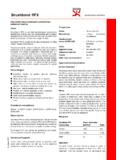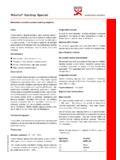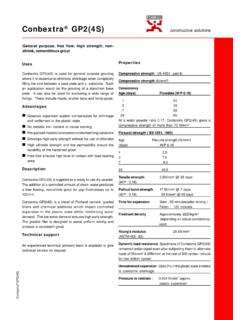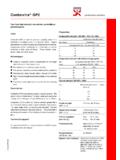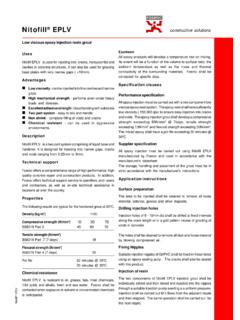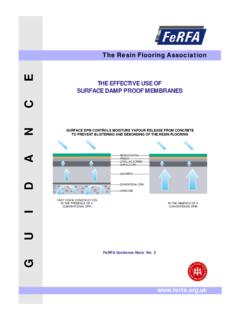Transcription of Nitoproof 100/120 constructive solutions - Nobel …
1 Nitoproof 100/120constructive solutionsNitoproof 100/120 Bituminous waterproof protective coatingUsesHorizontal and vertical damp- proof membranes in sandwichconstruction for floors, walls and lining of water storage tanks including for potablewater. External treatment of below ground structures againstwater ingress and attack by aggressive ground Easy to use : Simple brush or trowel application Cold applied :No heating or dangerous handling Liquid membranes : Can be applied to rough orcontoured surfaces. No joints :Continuous unbroken film Non toxic : Safe with drinking complianceNitoproof 100 and 120 comply with IS:9862 - 1981 specificationfor ready mixed paint, brush applied bituminous, black, lead-free, acid, alkali, water and chloride also meet the requirements for coatings suitable for useon surfaces in contact with potable water - tested by PublicHealth Institute, 100 and 120 are based on raw materials which areamongst the most water and water-vapour resistant surfacecoating materials available.
2 They are also resistant to a widerange of chemical selected bitumens are blended to produce variousgrades, each designed to provide the best possible protectivecoating for its practical 120 incorporates fibres which give body to the filmand act as reinforcement in the coating, eliminating crackingand crazing under conditions of thermal : In common with all bituminous and tar based coatings,and many other organic materials, Nitoproof 100 and 120 aresusceptible to prolonged exposure to ultraviolet light and arenot, therefore, recommended for use in situations where theywill be exposed to direct daylight. They are however, ideallysuited for use in sandwich constructions, or as surface coatingsin enclosed tanks or structures, or below ground, where theirdurability is well SupportAn experienced technical advisory team is available to givetechnical service on instructionsSurface preparationPreparation of surfaces prior to the application of Nitoproof 100and 120 is most must be clean and dry and all loosely adhering particlessuch as rust, mill scale, soft mortar, cement laitence or oldcoatings must be carefully and thoroughly removed by wirebrush and/or using Reebaklens.
3 All dust must be removed bysoft brushing. Surfaces must also be free from oil or a mortar or concrete surface is smooth and shiny as theresult of 'polishing' with a steel trowel, it must be lightly wirebrushed to ensure a satisfactory the case of newly emptied water tanks in contact with water,the body of the surface must be allowed to dry out thoroughlybefore application. Otherwise, residual water may prevent asatisfactory bond being 100 and 120 should not be applied to surfaces whichare wet. In such cases, Fosroc should be consulted foralternative : The strength and reliability of any coating is only asgood as the surface on which it is applied. If this is weak orpowdery, such as soft or friable mortar or poor concrete; or flaky,as cement laitence or old coating material; then the Nitoproof100 and 120 membrane may fail along with the any surface is suspect, it should be chipped off or cutback to sound material and, if necessary, made good withsuitable good quality mortar or concrete, and well cured, priorto coating with Nitoproof 100 and surfaces should first be primed with one full coat of Nitoproof100 to ensure the adhesion of subsequent coats of eitherNitoproof 100 or Nitoproof 120.
4 The coverage obtained with thepriming coat of Nitoproof 100 will vary considerably with thenature and porosity of the substrate but will typically be in therange of to / 100/120To determine if one coat is sufficient, is best judged by the colourafter drying. If a dense and even black coating is obtained, thesurface may be adequately primed irrespective of coverageobtained. If the coating is patchy in appearance, then a furthercoat is necessary to ensure satisfactory coatingOnce the priming coat of Nitoproof 100 is dry, it may be overcoatedwith either further coats of Nitoproof 100 or Nitoproof 120according to the requirements, allowing each to dry completelybefore applying the successive coat must be applied at right angles tothe previous one to ensure efficient filling to brush marksand low spot and a satisfactory overall film thickness.
5 Medium stiffness bristle brushes are recommended for bothNitoproof 100 and Nitoproof 120 but should not be too stiffas to cause grooving of the case where a very heavy bodied coat is required, Nitoproof130 may be used and should be applied with a steel 100 and Nitoproof 120 must be brushed evenlyand not allowed to form pools in hollows and, particularly,in troughs or rough tamped concrete. Otherwise, a surfaceskin may form causing solvent entrapment before completedrying can occur. This may later give rise to blow holes inthe protective timesUnder warm dry conditions where good ventilation and aircirculation exists, drying both Nitoproof 100 and Nitoproof 120 isfairly rapid. Typically 4 to 8 hours in cool or very humid weather, , during monsoon, or in enclosed tanks or spaces with littleventilation or air flow, 24 hours or even more may be requiredbefore each coat is dry.
6 In case of enclosed water tanks finalfilling of tanks should wait for a minimum of three days or untilthe last coat dries and all solvent vapour has and jointsEffective coating over cracks and joints in the substrate isdependent upon their size and extent and whether they are liableto further cracks : Fine hair-line cracks which are confined tothe surface of the substrate only, can generally be sealed with acombination of one coat of Nitoproof 100 followed by two coatsof Nitoproof cracks and construction joints : Provided theseare not subject to further movement or only very minor movementtreatment is crack is relatively wide, say 2mm or more, it should be rakedout to approximately 6mm width and 6 to 12mm depth to form agroove with vertical sides. A Vee shaped groove is formed groove may then be filled with a suitable repairmaterial such as Nitomortar PE, a polyester repair mortar orConbextra GPI, cementitious grout mixed to mortar consistency,and applied in accordance with manufacturer's instructions.
7 Verynarrow cracks do not normally require a piece of gunny cloth or glass fibre mesh ofsufficient size to overlap the crack or joint by 75 mm on eitherside and beyond it in each one full coat of Nitoproof 100 over the area of thesurface to be covered and, whilst still wet, press the clothstrip firmly onto the Nitoproof , follow this with another coat of Nitoproof 100over the reinforced area by using the brush as stippler, workthe Nitoproof 100 through the cloth to fuse with the wetNitoproof 100 beneath. This fusing of the Nitoproof 100 coatis important, and, when dry, will hold the cloth strip coatings, usually with Nitoproof 120, are thenapplied over the entire surface to be treated, once thecloth strip is set and of cracks and joints : In all cases where these occur,it is likely that cracks will propogate through any protective film,including additional screed or plaster covering, and an alternativemethod of sealing such cracks or joints must be 100 and 120 are not recommended in such joints.
8 In all structures where it is required to coatover the intersection between vertical walls and base slabs, orbetween adjacent walls, special care should be such intersections form a right angle, it is recommendedthat, after first priming with Nitoproof 100 or Nitoproof 120, a filletshould be provided at the intersections do not form a right angle, either due to priorshaping of the substrate or the line of the structural membersforming a shallow angle, then reinforcement of the area upto75mm either side of the joint is recommended. This should bedone using gunny cloth or glass fibre mesh as described forshrinkage cracks and construction 100/120 CovingsThe junction between concrete slab and parapet wall shall betreated with polymer modified mortar using Nitobond toppingsWhere Nitoproof 100 and 120 membrane is to be covered witheither concrete or sand/cement layer or tiles are to be bedded onmortar.
9 The final coat of Nitoproof 120, whilst stillwet, should besprinkled liberally with 3mm clean grit ( Not sand or dustyaggregate ). When the coating is dry all loose grit should beremoved with a soft brush, to leave the remainder embedded inthe coating to form a key for topping which can then be plasteringThe provision of a grit key is not feasible on vertical surfacesexcept where the coating is carried only a short distance, say100mm or so, up a a complete sandwich construction, such as an inner liningwall of bricks, blocks or poured concrete is intended, then it isnecessary to provide a mechanical key for plastering. A suitableand proven method is the vertical surface fully with Nitoproof 100 and 120 tothe finished and plug the wall at intervals of a maximum of 300mmin each direction using suitable galvanised screws or nailsinto galvanised wire mesh of 20mm to 25mm gauge,tightly stretched between fixings and held slightly off the sand/cement mortar, preferably incorporatingConplast X421IC, integral waterproofing admixture, plasterthe wall in the normal way making sure a good bond isobtained with the mesh.
10 Generally two thin coats, say 20mmof plaster with suitable setting time between each, arepreferable to one thicker coat. The first coat of plaster isscratched to form a key for the : Drilling through Nitoproof 100 and 120 membrane doesnot normally impair the water resistance of the overall film but ifundue disturbance is feared, the area around each fixing shouldbe spotted with Nitoproof 100 before attaching the and equipment should be scraped as clean as possibleand all remaining Nitoproof 100 and 120 should be removedwith white spirit or kerosene. Spillages of Nitoproof 100 and 120should be covered with sand or sawdust and later removed asfar as possible by scraping. The use of solvent is notrecommended as this may extend the risk of applicationsNitoproof 100 and 120 have a wide range of uses and there arefew buildings or other structures where they may not be used insome part of the construction to meet a specification or overcomea problem, where a water resistant membrane is applicationsare.

